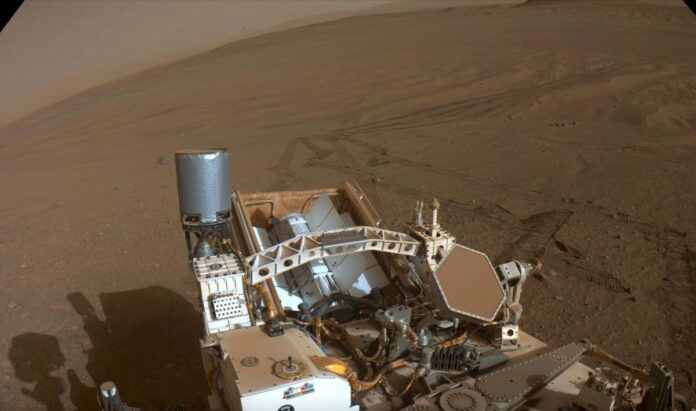Two years ago today, NASA’s Perseverance rover made its white-knuckle arrival on the surface of another world.
On Feb. 18, 2021, a rocket-powered sky crane lowered the car-sized Perseverance and its tiny ridealong partner, the Ingenuity helicopter, to the floor of Mars’ Jezero Crater, then flew off to crash-land a safe distance away.
Perseverance and Ingenuity have been extremely busy ever since, as have their handlers here on Earth. But the two-year milestone offers a chance for everyone to take a step back and appreciate how much the missions have accomplished thus far.
“Anniversaries are a time of reflection and celebration, and the Perseverance team is doing a lot of both,” Perseverance project scientist Ken Farley, of the California Institute of Technology in Pasadena, said in a NASA statement on Friday (Feb. 17) (opens in new tab).
“Perseverance has inspected and performed data collection on hundreds of intriguing geologic features, collected 15 rock cores and created the first sample depot on another world,” Farley added. “With the start of the next science campaign, known as ‘Upper Fan,’ on Feb. 15, we expect to be adding to that tally very soon.”
Related: 12 amazing photos from the Perseverance rover’s 1st year on Mars
As Farley’s words suggest, sample collection is one of Perseverance’s chief mission objectives. The rover is drilling out rock cores and scooping up Mars regolith (dirt and gravel), material that a joint NASA-European Space Agency (ESA) campaign plans to bring back to Earth as early as 2033.
Perseverance has filled 18 of its 38 titanium sample tubes so far. Fifteen hold rock cores, as Farley noted, two contain regolith, and one is an “atmospheric sample” captured after the rover’s first drilling operation went awry. (The rover also carries five “witness tubes,” which are designed to help the mission team determine if any sealed sample tubes might contain contaminants from Earth.)
The baseline sample-return architecture calls for ESA to launch an Earth Return Orbiter (ERO) in 2027 and NASA to send a rocket-equipped Sample Retrieval Lander (SRL) toward Mars the following year.
If all goes according to plan, Perseverance will drive its sample haul over to the SRL, which will touch down inside the 28-mile-wide (45 kilometers) Jezero. The SRL’s onboard rocket will then launch the Mars material to orbit, where it will be grabbed and hauled to Earth by the ERO.
There’s no guarantee that Perseverance will still be healthy in the late 2020s, however — and that’s where the depot comes in. As a backup, the rover recently dropped 10 sample tubes in a section of Jezero the mission team calls Three Forks. If need be, two Ingenuity-like helicopters that will launch aboard the SRL will collect the depot tubes one by one, bringing them back to the lander for launch.
After Perseverance’s samples reach Earth, they’ll be analyzed by scientists in well-equipped labs around the world. Many of these researchers will hunt for signs of ancient Mars life, for Jezero was once a habitable environment; it harbored a big lake and a river delta billions of years ago.
The six-wheeled robot is conducting a life search of its own inside Jezero, but such work is complicated; confirmation of life on Mars may be beyond the capabilities of a lone robot with a limited scientific payload, mission team members have said. (That’s why getting those samples to Earth is such a high priority for NASA and astrobiologists around the world.)
Perseverance’s campaign will soon take it off the crater floor and onto the top of the ancient delta, an environment the rover has not yet explored.
Related: Life on Mars: Exploration and evidence
Ingenuity wasn’t supposed to be a big contributor to Perseverance’s mission; the 4-pound (1.8 kilograms) helicopter is a technology demonstrator, tasked with showing that aerial exploration is possible on Mars despite the planet’s thin atmosphere.
The little chopper quickly did just that, acing its five-flight original mission. And then it kept on flying, on an extended mission during which it’s serving as a scout for Perseverance. (Perseverance is now exploring on an extended mission as well; its prime mission lasted one Mars year, which is about 687 Earth days.)
Ingenuity has now completed 43 flights on the Red Planet, which together have covered nearly 5.5 miles (8.9 kilometers) of ground.
Perseverance is even more well-traveled than its aerial partner; the rover has put 9.05 miles (14.57 km) on its odometer since touching down. And some of its other numbers are truly mind-boggling.
For example, the rover has taken more than 166,000 images on Mars with its various cameras, mission team members said in Friday’s statement. Perseverance’s ground-penetrating radar instrument has performed 676,828 subsurface soundings to date, and its SuperCam instrument has fired its rock-zapping laser 230,554 times. In addition, SuperCam’s microphone has made 662 audio recordings since touchdown. There are more crazy Perseverance numbers in Friday’s statement as well; check it out here (opens in new tab).
Perseverance and Ingenuity aren’t the only NASA robots exploring the Martian surface.
The Curiosity rover, which is about the same size as Perseverance, has been exploring a 96-mile-wide (154 km) crater called Gale since August 2012.
Not long after landing, Curiosity determined that Gale hosted a potentially habitable lake-and-stream system for long stretches in the ancient past.
Since September 2014, the rover has been climbing Mount Sharp, which rises 3.4 miles (5.5 km) into the sky from Gale’s center. Curiosity is reading the rock layers as it goes, seeking clues about Martian environmental change over time.
Mike Wall is the author of “Out There (opens in new tab)” (Grand Central Publishing, 2018; illustrated by Karl Tate), a book about the search for alien life. Follow him on Twitter @michaeldwall (opens in new tab). Follow us on Twitter @Spacedotcom (opens in new tab) and on Facebook (opens in new tab).

